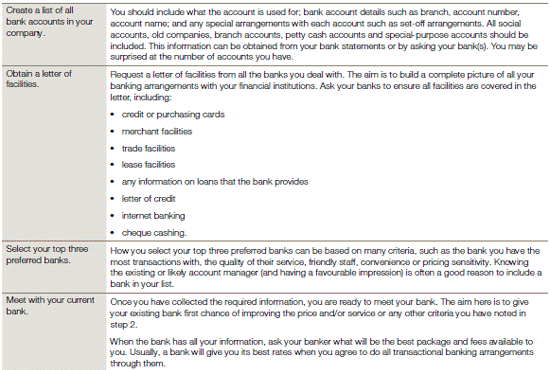
By David Searle*
 For many small businesses, the initial financing arrangements implemented at start-up are still in place many years later.
For many small businesses, the initial financing arrangements implemented at start-up are still in place many years later.
For example, a business starts off with a simple overdraft facility and arranges for several modest increases in the facility without considering the cost–benefit of the facility or the suitability of the debt arrangements to its needs.
Small business owners are encouraged to review existing debt finance arrangements regularly to ensure the finance facility and structure fit the current needs of the business.
You may find there is a strong business case for refinancing the business.
This process should not be undertaken lightly, as there are many pitfalls in changing lenders, all of which should be considered as part of your review.
Refinancing your debt finance may involve:
• changing lending institutions (but retaining the same debt products)
• funding the business from different debt products (with the same or a different lender)
• combining debt into a single facility or product
• increasing or decreasing the total amount of the borrowing as part of the refinancing
• changing the repayment amount or timing
• increasing or decreasing the security offered to the lender(s).
HINT
Refinancing can involve a number of alternatives. To achieve the best outcome, ensure you understand all the alternatives before committing to a new lender.
How refinancing works
Refinancing involves taking out a new debt facility in order to use the new funds to pay out your old debt facility. This is all done by the new lender. If the refinancing involves an increase in debt, then additional funds would be available to draw on.
The key reasons why you choose to refinance may include:
• gaining a better interest rate from a different lender or from a different mix of debt products
• switching to fixed rates or back to variable rates
• gaining more flexible features in a facility to meet your business needs
• increasing your overall borrowing with a new debt facility
• changing the financial cash flow commitment required to fund debt (for example, fully drawn advance to an overdraft)
• consolidating debts to minimise and simplify repayments
• releasing security over personal/specific assets as the business reaches a level of continued profitability.
HINT
Make a list of the reasons why you might consider refinancing your loan to compare against the loan offer you receive.
Benefits of refinancing
Many benefits may be gained from refinancing. Some of these are outlined below.
HINT
After carefully undertaking a cost–benefit evaluation of refinancing, you may find it brings a range of new opportunities to your business.
A new perspective based on your current position and not the past
You may find that a “fresh start” with a new lender does not carry any of the long-term pre-conceptions that your previous lender may have been influenced by.
These may have included a poor trading period in earlier years or a particular experience they had with another customer in your industry, which influenced their lending decision-making against your interests.
Access to increase in debt finance
Refinancing may also result in increasing the finance available for business growth.
You should ensure that, in taking on additional debt, you can still service the higher debt commitment and that these funds are utilised to achieve a higher return for the business.
Consolidation of debt funding - cash flow savings
There is often an opportunity to combine a number of ad-hoc debt finance arrangements into a single product to simplify repayments and potentially to reduce your monthly cash flow repayment commitment.
Restructuring security offering
Refinancing may also provide the opportunity for a change in the security being offered to the new lender. You may find that, over time, the value of security offered to the existing lender has increased at a far greater rate than the level of borrowing. When you negotiate your refinancing, review what is a reasonable offer of security assets.
HINT
Refinancing a strong, healthy business may create an opportunity to separate your personal assets from security offered if the value of the business assets (such as commercial land and building, debtors and fixed assets) is sufficient to cover the borrowing.
Common dangers in refinancing
When considering refinancing, make certain you understand all the implications before changing your facilities.
HINT
Ensure you have undertaken sufficient review of your circumstances prior to making any commitments on refinancing, as there are many pitfalls that may undermine any perceived benefit.
What is the cost of paying out your existing debt facility?
Your existing facility may have an “early repayment penalty” clause, which could outweigh any future interest savings. Other exit fees may include discharge of mortgage costs if property is involved as security. Deferred establishment fees may apply.
What will be the ingoing costs of the new finance facility?
Changing to a new lender (as opposed to a new product with the same lender) will require additional costs such as application, documentation, valuation (to value your security assets), mortgage fees and settlement fees. If your new lender is keen to get your business, you may be able to negotiate a waiver of some of the bank’s internal costs as part of the package.
Impact of security assets used to support multiple borrowings
When you are refinancing, you need to be aware of how your existing financing is linked to your security assets.
For example, your existing bank may provide an overdraft facility, using security over your residential property, as well as an EFTPOS/credit card facility and access to an automated payroll system to transfer funds into employee bank accounts.
If you change your debt facilities to a lender that does not have retail facilities such as EFTPOS and credit card processing, you may find you need additional security to guarantee these facilities.
Change in valuation of your security
Before you commit to a change of lender or product you need to ensure you have in place a firm letter of offer and not one that is subject to satisfactory valuation or a third- party validation (such as a mortgage insurer) on the security required. Different lenders can come back with lower or higher valuations of your property, depending on the value used or the current market conditions.
Impact of leaving a long-term banking relationship
You need to assess the strength of your long-term relationship with your current lender. Do you have some intangible benefits now, because the current lender knows your banking and business history, that you may not be afforded in a new relationship?
How to switch banks
A good banking relationship is crucial to your business operation and, in many cases, the financial survival of your business.
Banks are vital to the financing of your business operation, and a good relationship with your bank can help you negotiate better terms for your banking needs. Even if you are satisfied with the service quality of your bank, you should still meet with your bank at least once a year to discuss your banking requirements and areas of improvements in products and services that your business could use.
If you are not happy with the service of your bank, you should review your bank accounts and facilities. What you should not do is move to another bank without comparing the services provided by your current bank(s) with those of the new provider.
Many businesses split their banking between two or more financial institutions to have more control over their financial arrangements. These businesses usually have one main bank provider who does most of their banking transactions. If you are dissatisfied with the pricing or service levels of your main provider, you should compare its offer with those of other banks.
TIP
Make a list of all these points and note the pros and cons for each point to help assess whether to refinance.
Banking review
You can use the following checklist to help you review your bank accounts and facilities:


You should consider the following factors before you change banks:
• Will your business incur additional costs as a result of switching banks (for example, costs in notifying customers and suppliers, and changing deposit and chequebooks)?
• Is the new bank’s service level good? You may be able to find out by talking to some of their customers. You may have customers or suppliers who have an account with the new bank.
• Give preference to the bank that allows you to meet with bank staff other than your account manager. This should include the bank manager and perhaps even the regional manager. Often, staff change regularly within banks, so it is preferable that more than one staff member of the chosen bank has an understanding of your business and the banking relationship.
------------------------------------------------------------------------------------------------------
The full Guide is available in the .pdf attachment, or here »
------------------------------------------------------------------------------------------------------
David Searle is an Assurance Services Partner with Staples Rodway and is the immediate past president of CPA Australia New Zealand Division. You can contact them directly here »
You can read the Introduction to this series here » The related Glossary is an important resource. And readers are encouraged to read this page first »
Chapter 1 is about Understanding financial statements and you can read it here »
Chapter 2 is about Assessing your busines's financial health and you can read it here »
Chapter 3 is about the Importance of Budgeting and you can read it here »
Chapter 4 is about the Maintaining Profitability and you can read it here »
Chapter 5 is about the Improving Cashflow and you can read it here »
Chapter 6 is about the Managing Cashflow and you can read it here »
Chapter 7 is about the Debt, equity or internal funds? and you can read it here »
Chapter 8 is about the Transactional banking and you can read it here »
Chapter 9 is about the Importing and exporting finance and you can read it here »
Chapter 10 is about the Applying for a loan and you can read it here »
Chapter 12 is about Managing your banking relationships and will follow next week.
We welcome your comments below. If you are not already registered, please register to comment
Remember we welcome robust, respectful and insightful debate. We don't welcome abusive or defamatory comments and will de-register those repeatedly making such comments. Our current comment policy is here.